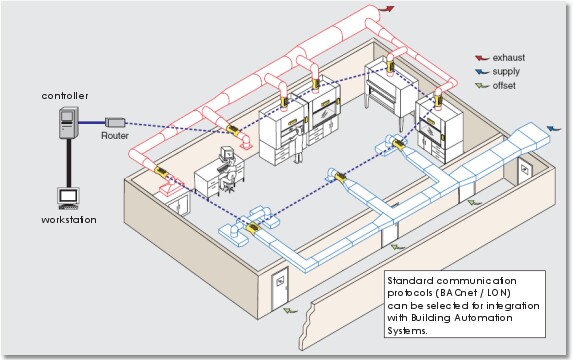Existing Conditions
The laboratory fume hood exhaust system incorporates a xxx hp exhaust fan to draw xxx cfm from xxx fume hoods <incorporates a separate exhaust fan for each of xxx fume hoods, extracting approximately xxx cfm from each hood while in operation>. The fume hood users control air flow in a limited way by raising or lowering the glass sashes at the front of each fume hood. The fan runs <fans run> at full speed regardless of fume extraction requirements. A make-up air unit with a xxx hp fan replaces the exhausted air with heated or cooled outside air.
The exhaust and makeup air systems are designed for peak requirements, so they move more air than necessary most of the time.
Retrofit Conditions
Modern laboratory exhaust systems make use of digital automation systems to vary system capacity in response to requirements at the fume hoods. We recommend that the existing system be equipped with modern controls to minimize the exhaust and makeup air flows without compromising safe laboratory conditions.
Each fume hood is equipped with a special-purpose controller incorporating sash position sensing, airspeed sensing, and detection of operator presence directly in front of the hood. The controller modulates an air valve above the hood to throttle air flow in response to requirements. The exhaust fan<s> and makeup air fan would be equipped with either variable frequency drives or bypass arrangements to control air flow to the exact requirements indicated by the fume hoods.
Makeup air is modulated to track total exhaust flow and ensure a slight positive pressure in the laboratory at all times.

Further Benefits
With an overall reduction in air flow through the laboratory, temperature control in the space becomes easier. If the retrofit is well designed and commissioned, the conditioned space is likely to be more comfortable for occupants.
Application Details
This application is suitable for manifolded laboratory exhaust systems (several fume hoods on one exhaust fan). A slightly different approach, using variable frequency drives and motors on each fume hood, is used where hoods are separately exhausted.
Issues and Concerns
References
Analysis
Analysis will be on a case-by-case basis, depending on how the hoods are used. Do the operators turn off the fans when not in use, and what do they do with the sashes?
There are a few rules of thumb that can be used:
Older hoods: typical airflow is 150 fpm across sash opening, with sash open.
New bypass-style hoods: designed for 80 fpm to 130 fpm at a working sash height of 18". Airflow while on, but in the absence of an operator, is half
New variable volume hoods: designed for 100 fpm to 130 fpm regardless of sash height. This is the calculation range used for the recommended system. Airflow while on, but in the absence of an operator, is half the design flow.